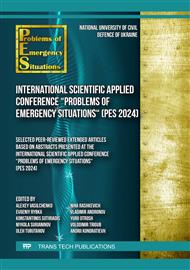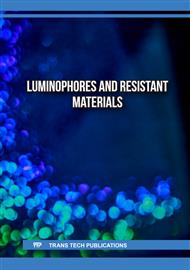[1]
I. Glassman, R.A. Yetter, Combustion, London, Elsevier, (2014).
Google Scholar
[2]
S.S. Kaim, S.D. Kaim, R. Rojek, Mechanism of "Hot Points" Generation in Fronts of Detonation Waves in Condensed Energetic Materials, Nanosystems. Nanomaterials. Nanotechnologies, 7(4) (2009) 1201–1226.
Google Scholar
[3]
S.D. Kaim, Nano Gas dynamics of gas and dust emissions in coal mines, Nanosystems. Nanomaterials. Nanotechnologies, 10(3) (2012) 609–628.
Google Scholar
[4]
O. Zavialova, M. Grygorian, V. Kostenko, N. Liashok, T. Kostenko, V. Pokaliuk, Theoretical basis for the formation of damaging factors during the coal aerosol explosion, Mining of Mineral Deposits, 15/4 (2021) 130–138.
DOI: 10.33271/mining15.04.130
Google Scholar
[5]
H. Zhu, K. Sheng, Y. Zhang, S. Fang, Y. Wu. The stage analysis and countermeasures of coal spontaneous combustion based on "five stages" division, PLoS One, 13(8) (2018) e0202724.
DOI: 10.1371/journal.pone.0202724
Google Scholar
[6]
A. Yaxin, K. B. Karteek, A.D. Sanket, Development of New Transferable Coarse-Grained Models of Hydrocarbons, J. Phys. Chem., 122(28) (2018) 7143–7153.
DOI: 10.1021/acs.jpcb.8b03822
Google Scholar
[7]
N. Gaston, Cluster melting: new, limiting, and liminal phenomena, Adv. Phys., 3(1) (2018) 1401487.
DOI: 10.1080/23746149.2017.1401487
Google Scholar
[8]
Yu. Hapon, D. Tregubov, E. Slepuzhnikov, V. Lypovyi, Cluster Structure Control of Coatings by Electrochemical Coprecipitation of Metals to Obtain Target Technological Properties, Solid State Phenomena, 334 (2022) 70–76.
DOI: 10.4028/p-4ws8gz
Google Scholar
[9]
Z. Li, H.T. Chen, K. Schouteden, T. Picot, T.-W. Liao, A. Seliverstov, C. Van Haesendonck, G. Pacchioni, E. Janssens, P. Lievens, Unraveling the atomic structure, ripening behavior, and electronic structure of supported Au20 clusters, Sci. Adv., 6(1) (2020) eaay4289.
DOI: 10.1126/sciadv.aay4289
Google Scholar
[10]
A.S. Olson, A.J. Jameson, S.K. Kyasa, B.W. Evans, P.H. Dussault, Reductive Cleavage of Organic Peroxides by Iron Salts and Thiols, ACS omega, 3(10) (2018) 14054–14063.
DOI: 10.1021/acsomega.8b01977
Google Scholar
[11]
J.E. House, Inorganic Chemistry, California, Elsevier (2010).
Google Scholar
[12]
D. Tregubov, O. Tarakhno, V. Deineka, F. Trehubova, Oscillation and Stepwise of Hydrocarbon Melting Temperatures as a Marker of their Cluster Structure, Solid State Phenomena, 334 (2022) 124–130.
DOI: 10.4028/p-3751s3
Google Scholar
[13]
Quickly find chemical information from authoritative sources, Pubchem, U.S. National Library of Medicine. Information on https://pubchem.ncbi.nlm.nih.gov/
Google Scholar
[14]
D. Tregubov, I. Dadashov, V. Nuianzin, O. Khrystych, N. Minska, Relationship Between Properties of Floating Systems and Flammable Liquids in the Stopping Their Burning Technology, Key Engineering Materials, 954 (2023) 145–155.
DOI: 10.4028/p-krzrd9
Google Scholar
[15]
D. Tregubov, E. Slepuzhnikov, M. Chyrkina, A. Maiboroda, Cluster Mechanism of the Explosive Processes Initiation in the Matter, Key Engineering Materials, 952 (2023) 131–142.
DOI: 10.4028/p-lzz2hq
Google Scholar
[16]
R. Meyer, J. Köhler, A. Homberg, Explosives, Weinheim, Wiley-VCH, (2016).
Google Scholar
[17]
D. Tregubov, O. Tarakhno, D. Sokolov, F. Tregubova, The oscillation of n-alkanes characteristic temperatures under the action the cluster structure of substance, Problems of emergency situations, 32 (2020) 14–30.
Google Scholar
[18]
Search for Species Data by Chemical Name, NIST Chemistry WebBook, U.S. Department of Commerce.
Google Scholar
[19]
D. Tregubov, N. Minska, E. Slepuzhnikov, Yu. Hapon, D. Sokolov. Substances explosive properties formation. Problems of Emergency Situations, 36 (2022) 41–53.
DOI: 10.52363/2524-0226-2022-36-4
Google Scholar
[20]
The Engineering ToolBox. Hydrocarbons – Autoignition Temperatures and Flash Points. Information on https://www.engineeringtoolbox.com/flash-point-autoignition-temperature-kindling-hydrocarbons-alkane-alkene-d_1941.html.
Google Scholar
[21]
M. Salinga, E. Carria, A. Kaldenbach, M. Bornhöfft, J. Benke, J. Mayer, M. Wuttig, Measurement of crystal growth velocity in a melt-quenched phase-change material, Nat Commun., 4 (2013) 2371.
DOI: 10.1038/ncomms3371
Google Scholar
[22]
R. Rosa, P. Veronesi, C. Leonelli, Use of combustion synthesis / self-propagating high- temperature synthesis (SHS) for the joining of similar/dissimilar materials, Woodhead Publishing Reviews: Mechanical Engineering Series, (2022) 63–79.
DOI: 10.1016/b978-0-323-85399-6.00013-8
Google Scholar
[23]
B. Pospelov, V. Andronov, E. Rybka, V. Popov, A. Romin, Experimental study of the fluctuations of gas medium parameters as early signs of fire, Eastern-European Journal of Enterprise Technologies, 1(10–91) (2018) 50–55.
DOI: 10.15587/1729-4061.2018.122419
Google Scholar
[24]
B. Pospelov, V. Andronov, E. Rybka, R. Meleshchenko, S. Gornostal, Analysis of correlation dimensionality of the state of a gas medium at early ignition of materials, Eastern-European Journal of Enterprise Technologies, 5(10) (2018) 25–30.
DOI: 10.15587/1729-4061.2018.142995
Google Scholar
[25]
R. K. Sharma, A violent, episodic vapour cloud explosion assessment: Deflagration-to-detonation transition, Journal of Loss Prevention in the Process Industries, 65 (2020) 104086.
DOI: 10.1016/j.jlp.2020.104086
Google Scholar
[26]
K. Korytchenko, P. Krivosheyev, D. Dubinin, A. Lisniak, K. Afanasenko, S. Harbuz, O. Buskin, A. Nikorchuk, I. Tsebriuk, Experimental research into the influence of twospark ignition on the deflagration to detonation transition process in a detonation tube, East.-European J. of Enterprise Technol., 4 (2019) 26–31.
DOI: 10.15587/1729-4061.2019.175333
Google Scholar
[27]
K. Korytchenko, A. Ozerov, D. Vinnikov, Y. Skob, D. Dubinin, R. Meleshchenko, Numerical simulation of influence of the non-equilibrium excitation of molecules on direct detonation initiation by spark discharge, Problems of Atomic Science and Technology, 4(116) (2018) 194–199.
DOI: 10.46813/2021-134-171
Google Scholar
[28]
K. Korytchenko, O. Sakun, Y. Khilko, D. Dubinin, E. Slepuzhnikov, A. Nikorchuk, I. Tsebriuk, Experimental investigation of the fireextinguishing system with a gasdetonation charge for fluid acceleration. Eastern-European Journal of Enterprise Technologies, 3(9–93) (2018), 47–54.
DOI: 10.15587/1729-4061.2018.134193
Google Scholar
[29]
B. Pospelov, V. Andronov, E. Rybka, R. Meleshchenko, P. Borodych, Studying the recurrent diagrams of carbon monoxide concentration at early ignitions in premises. Eastern-European Journal of Enterprise Technologies, 3(9–93) (2018), 34–40.
DOI: 10.15587/1729-4061.2018.133127
Google Scholar
[30]
B. Pospelov, V. Andronov, E. Rybka, V. Popov, O. Semkiv, Development of the method of frequencytemporal representation of fluctuations of gaseous medium parameters at fire. Eastern-European Journal of Enterprise Technologies, 2(10–92) (2018) 44–49.
DOI: 10.15587/1729-4061.2018.125926
Google Scholar
[31]
B. Pospelov, E. Rybka, R. Meleshchenko, S. Gornostal, S. Shcherbak, Results of experimental research into correlations between hazardous factors of ignition of materials in premises. Eastern-European Journal of Enterprise Technologies, 6(10–90) (2017) 50–56.
DOI: 10.15587/1729-4061.2017.117789
Google Scholar
[32]
K. Mygalenko, V. Nuyanzin, A. Zemlianskyi, A. Dominik, S. Pozdieiev, Development of the technique for restricting the propagation of fire in natural peat ecosystems, Eastern-European Journal of Enterprise Technologies, 1/10(91) (2018) 31–37.
DOI: 10.15587/1729-4061.2018.121727
Google Scholar
[33]
D. Dubinin, K. Korytchenko, A. Lisniak, I. Hrytsyna, V. Trigub, Numerical simulation of the creation of a fire fighting barrier using an explosion of a combustible charge, Eastern-European Journal of Enterprise Technologies, 6/10(90) (2017) 11–16.
DOI: 10.15587/1729-4061.2017.114504
Google Scholar
[34]
B. Pospelov, V. Andronov, E. Rybka, S. Skliarov, Research into dynamics of setting the threshold and a probability of ignition detection by selfadjusting fire detectors, Eastern-European Journal of Enterprise Technologies, 5/9(89) (2017) 43–48.
DOI: 10.15587/1729-4061.2017.110092
Google Scholar
[35]
B. Pospelov at al, Development of the correlation method for operative detection of recurrent states, Eastern-European Journal of Enterprise Technologies, 6/4 (102) (2019) 39–46.
Google Scholar
[36]
A. Teslenko at al, Construction of an algorithm for building regions of questionable decisions for devices containing gases in a linear multidimensional space of hazardous factors, Eastern-European Journal of Enterprise Technologies, 5/10(101) (2019) 42–49.
DOI: 10.15587/1729-4061.2019.181668
Google Scholar
[37]
A. Chernukha, A. Teslenko, P. Kovaliov, O. Bezuglov, Mathematical modeling of fire-proof efficiency of coatings based on silicate composition, Materials Science Forum, 1006 (2020) 70–75.
DOI: 10.4028/www.scientific.net/msf.1006.70
Google Scholar



